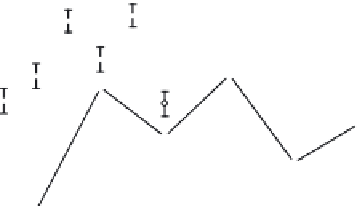Biomedical Engineering Reference
In-Depth Information
conclusion made is that after exposure to organic solvents, the enzymes may retain up
to 100% of their initial activity in water.
The relative remaining activity of alcohol dehydrogenase in an optimal water-
ethanol mixture exceeded 100%. The observation of the improved activity of some of
the enzyme samples after this procedure [179] was a precursor to later achievements
on enzyme activation in organic media [178].
13.5.3.2 Enzyme-containing perfl uorosulfonated membranes
The procedure for the preparation of enzyme containing polymer membranes according
to the proposed protocol is simple: casting of the mixture containing the enzyme suspen-
sion and polymer solution in organic solvent over the target surface and allowing the
volatile organic solvent to evaporate. The casting solution is prepared by (i) a suspension
of enzyme in organic solvent and (ii) mixing of the enzyme suspension with the polymer
solution.
On the basis of the knowledge that different polyelectrolytes can stabilize proteins
[180], even in water-organic mixtures [181], it was important to check the membrane-
forming polyelectrolyte itself as a potential stabilizer. Indeed, as was found from spec-
trophotometric investigations, Nafi on stabilizes glucose oxidase suspensions in organic
solvents.
Suspending enzyme in polymer solution instead of in pure organic solvent not only
simplifi es preparation of the casting solution, the enzyme suspensions became more
uniform and stable. It was also found that at certain concentrations (enzyme, polyelec-
trolyte, and water) the resulting membranes exhibited extremes in both stability and
100
80
60
40
20
0
0
5
10
15
20
25
30
% H
2
O
FIGURE 13.7
The remaining activity of alcoholdehydrogenase (
) and glucose oxidase (
, ∆) after
30 minutes exposing to concentrated ethanol (
), isopropanol (∆), and acetonitrile (
) as a function of water
content in water-organic mixture.

























Search WWH ::

Custom Search